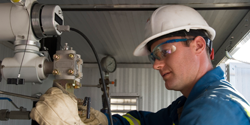American Energy Manufacturing Technical Corrections Act of 2012

American Energy Manufacturing Technical Corrections Act of 2012
The following is a summary of the American Energy Manufacturing Act of 2012 (H.R. 6582) as it was amended and passed by the House under suspension of the rules and passed by the Senate under unanimous consent. The original bill was introduced in the House by Representative Robert Aderholt (R-AL) on November 2, 2012. This legislation is a modified version of H.R.4850, the Enabling Energy Saving Innovations Act, as it was passed by the Senate.
The highlighted yellow sections are provisions related to appliance efficiency standards from the Implementation of National Consensus Appliance Agreements Act of 2011 (INCAAA), S.398, that were added in an amendment to H.R.4850 by Senator Jeff Bingaman (D-NM). Highlighted blue sections include industrial efficiency and federal agency energy efficiency provisions from Senator Jeanne Shaheen (D-NH) and Rob Portman's (R-OH) Energy Savings and Industrial Competitiveness Act (ESICA), S.1000.
Section 1: Short Title
This section gives the short title.
Section 2: Innovative Component Technologies
This section would amend the Energy Policy and Conservation Act to allow an exemption from the current standard for walk-in coolers and walk-in freezers if a component manufacturer demonstrates to the Department of Energy (DOE) that the component reduces energy consumption at least as much as if the standard were to apply.
Section 3: Uniform Efficiency Descriptor for Covered Water Heaters
This section would amend the Energy Policy and Conservation Act to direct DOE to establish a single efficiency descriptor and accompanying test methods for all covered water heaters, including both storage and instantaneous water heaters. The final rule may exclude specific categories of commercial water heaters.
Section 4: Service Over the Counter, Self-Contained, Medium Temperature Commercial Refrigerators
This section would amend the Energy Policy and Conservation Act to define and set a separate weaker standard for service over the counter, self-contained, medium temperature commercial refrigerator, the type with glass displays typically used in deli counters and bakeries.
Section 5: Small Duct High Velocity Systems and Administrative Changes
This section would amend the Energy Policy and Conservation Act to define and set a separate standard for small duct high velocity central air-conditioner and heat pump systems, which are sometimes used to install air conditioning in existing homes. The standards would be updated when DOE reviews other air conditioner and heat pump standards.
This section would also clarify that the requirement that DOE review commercial equipment standards every 6 years applies to standards issued before the requirement was enacted in 2007, with review due before the end of 2013. And it would set deadlines for DOE to respond to petitions from interested persons to amend any existing standard, with a decision on whether to conduct a rulemaking due within 180 days, and the final standard due three years later.
Section 6: Coordination of Research and Development of Energy Efficient Technologies for Industry
This section would establish collaborative research and development partnerships between the DOE Industrial Technologies Program and other offices within the Department to promote early stage energy efficiency technology development; support applied research and development, demonstration and commercialization of innovative manufacturing processes for improving efficiency (including improvements in efficient use of water), reducing emissions and waste, and improving industrial cost-competitiveness; and apply the knowledge and expertise of the Industrial Technologies Program to help achieve program goals of other offices.
Section 7: Reducing Barriers to the Deployment of Industrial Energy Efficiency
This section would require DOE to conduct a study examining the legal, regulatory, and economic barriers to the deployment of industrial energy efficiency in all electricity markets, including identifying regulatory barriers, and analyzing examples of successful state, federal, and international policies and private initiatives that resulted in greater use of industrial energy efficiency. The study should also estimate economic benefits of providing the industrial sector with Federal energy efficiency matching grants of $5,000,000,000 for 5 and 10 year periods. DOE would then develop policy recommendations regarding the deployment of industrial energy efficiency. (S. 1000 did not include this section but included a related revolving loan program.)
Section 8: Best Practices for Advanced Metering
This section would require federal agencies to create implementation plans ,for how they will achieve metering requirements under the National Energy Conservation Policy Act (NECPA), including designating responsible personnel and demonstrating when the use of advanced metering devices is not practicable. It would also require DOE to develop and issue an annual best-practices report on advanced metering of energy use in federal facilities in collaboration with the Department of Defense and the General Services Administration. The report would include summaries and analysis of agency reporting and recommendations on standard requirements or guidelines for automated energy management systems, including standards for communications and security and means for facilitating continuous commissioning and evidence-based maintenance of buildings and building systems.
Section 9:Federal Energy Management and Data Collection Standard
This section would, for facilities covered under section 543(f) of NECPA, direct energy managers to use a web-based tracking system to publish energy and water consumption data on an individual facility basis, in addition to existing requirements for tracking compliance with energy and water audit requirements, cost and savings of implemented measures, and benchmarking of energy use.
Section 10: Technical Corrections
This section includes 17 technical corrections for appliance and lighting standards enacted in the Energy Independence and Security Act of 2007 (EISA) and the Energy Policy Act of 2005.
STAY EMPOWERED
Help the Alliance advocate for policies to use energy more efficiently – supporting job creation, reduced emissions, and lower costs. Contact your member of Congress.
Energy efficiency is smart, nonpartisan, and practical. So are we. Our strength comes from an unparalleled group of Alliance Associates working collaboratively under the Alliance umbrella to pave the way for energy efficiency gains.
The power of efficiency is in your hands. Supporting the Alliance means supporting a vision for using energy more productively to achieve economic growth, a cleaner environment, and greater energy security, affordability, and reliability.



